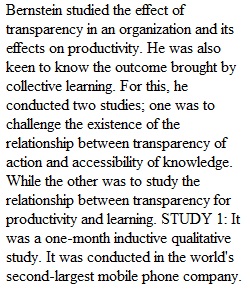


Q Introduction Each chapter contains a Research Analysis assignment based on some of the theory presented in that chapter. One of your assignments each unit (1 through 8) will be to review related research as directed and write an interpretation of your results. After completing your write up, please submit it by 11:59 p.m. Sunday CT. ________________________________________ Directions Using the cited research from the textbook as a starting point, you are to find a current (as recent as possible) related journal article, preferably on the same topic. You should then read the current article and compare its’ results and findings to those summarized in the text. After determining whether the results and findings are the same or different from those cited in the textbook, you then need to explain what those similarities or differences mean, in plain English. All cited material must include both internal citations and a complete reference list at the end of the paper. A cover sheet should minimally indicate the name of the Research Report, the name of the course, the student's name and the date. ________________________________________ Article Specific Directions Chapter 33, Research Report 33.1 – Transparency and collective learning The Bernstein (2012) article recent, so it may not be possible to find something more recent than this article. This is not important. The point of the exercise is to find another article dealing with observability of workers and collective learning effects. To that end it may be helpful to: 1. Use the library databases to search on “collective learning”, “observability of workers”, “transparency”, or “change” as well as the authors’ names to find related articles. The chapter may provide you with useful search terms as well. If you find the journal article itself in the library databases, note the associated subject terms for the article and use those to conduct your search. Given the difficulty that you may have in finding a direct match, if you find an article that deals with either observability of workers OR collective learning effects, that will be sufficient for this exercise. 2. Use Research report 29.1 to generate search terms, as previously suggested. The narrative has useful phrases that can be used for a literature search. 3. You do not want to merely summarize the article. You want to indicate whether the article you found is consistent or inconsistent with the Bernstein (2012) findings. Then you want to discuss what these results, as a whole (both articles together), mean to leaders and managers in terms of being able to consider the effects of collective learning and transparency on change efforts. ________________________________________ Due Date and Submission Requirements Submit by 11:59 p.m. Sunday CT. Rubric MBA636 Case Study/Research Analysis Rubric MBA636 Case Study/Research Analysis Rubric Criteria Ratings Pts This criterion is linked to a Learning OutcomeInterpretation and Critical Analysis 7 pts The response skillfully interprets and analyzes case (or research) in an insightful, original manner. The write up is edited to summarize the answer via a provided analytic framework and integration with required exercise elements. 6.25 pts The response sufficiently interprets and analyzes the case (or research) in adequate ways, though may lack originality and insight. Answers are longer because they are not edited as clearly and not reviewed as carefully. 5.5 pts The response interprets and analyzes the case (or research) in a predictable manner, summarizing ideas, rather than suggesting insights. 4.75 pts The response neither interprets nor analyzes case information (or research results and application). The write up is too long, since it is not as summarized. 7 pts This criterion is linked to a Learning OutcomeFocus 7 pts The responses provided tightly focus on key case ideas or themes (or research elements). 6.25 pts The response sufficiently focuses on a key textual idea or theme (or research elements). 5.5 pts The response sufficiently focuses on key textual ideas or themes (or research elements) but may wander from focus. 4.75 pts The response fails to focus on key case ideas or themes (or theory related to research or related assignment elements). 7 pts This criterion is linked to a Learning OutcomeDevelopment with use of adequate support (text & outside sources) 7 pts The responses are extremely well developed, using clear, applicable case examples closely linked to their interpretation (or to theory interpretation related to the research). Quotations and other matter conform to APA formatting requirements. 6.25 pts The response is sufficiently developed using case examples that are linked to its interpretations (or to theory interpretation related to the research), though it may lack sufficient development. Quotations conform to APA format requirements. 5.5 pts The response is underdeveloped and contains insufficient examples from the case (or research theory) that are not clearly linked to its interpretation. Quotations do not conform to APA format requirements. 4.75 pts The response lacks development and examples. It contains no quotations. 7 pts This criterion is linked to a Learning OutcomeTechnical 4 pts Response is clearly written with strong style and conforms to conventions of standard written English. 3.25 pts Response is adequately written and conforms to conventions of standard written English. 2.5 pts Response contains multiple errors not conforming to conventions of standard written English. 1.75 pts Response does not conform to the conventions of standard written English. 4 pts Total Points: 25 PreviousNext
View Related Questions